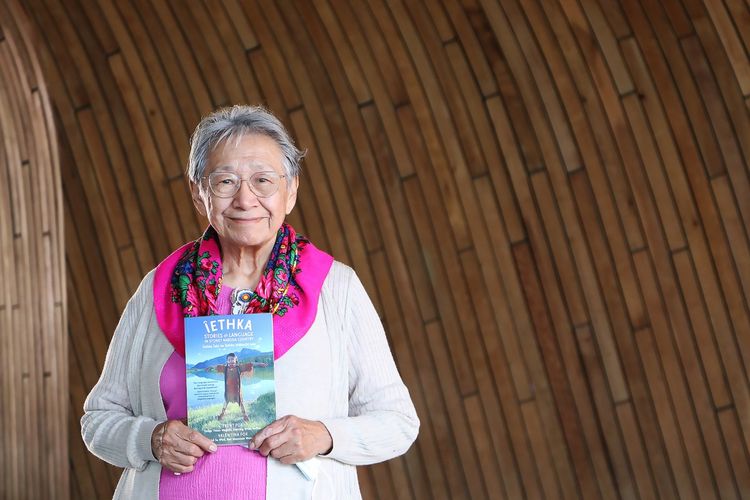ÎYÂRHE NAKODA – Red Mountain Woman (Îyâ Sa Wîyâ) still remembers her first catch.
It was during a hunting camp with relatives that Tina Fox – as she is known by many today – caught a grouse hiding beneath a willow tree by the neck with her bare hands.
A child at the time, she was brimming with pride. It was a grouse all her own, after all, or so she thought. That pride quickly soured into annoyance when the bird was whisked away by her grandmother to become a stew.
It was a valuable lesson in protocol, respect and sharing.
“This is the first time you have caught something,” her grandmother told her. “When a child or youth first catches something, they give it to an elder. This way, you will receive blessings in life.”
Now a respected elder preserving wisdom and traditions for future generations, Fox shares the cherished memory in her latest book, Îethka Stories & Language in Stoney Nakoda Country – a thoughtful collection of stories, poetry and Îethka values and language lessons.
The book is co-authored by her late son, Trent Fox, or Dancing White Buffalo (Tatâga Thkan Wagichi) as he is known in the Îethka language.
“He and I took a writing course together with the Calgary Public Library that was for Treaty 7 people. I’ve told him my stories and he told me, ‘why don’t you write about the grouse?’” said Fox.
“I had no idea what to write at first. He was better at writing in our language than I am because he’d taken some linguistic courses. So, he helped me with the writing system, and that became my first book.”
The children’s book is aptly titled Red Mountain Woman Receives a Teaching. Her son, meanwhile, published Grizzly Bear Woman Teaches the A’s, Â’s and B’s, also included in their shared book.
Îethka Stories & Language is about reclamation of identity. It’s a catalogue of oral teachings important to Îyârhe (Stoney) Nakoda culture. The term Îethka refers to both the language itself and to identify its people. Translated in English, it means speaker of a clear language, the book teaches.
Nearly every word of the 137-page book that is written in English, is also written in Îethka, or Stoney as it is sometimes referred to. The language did not have a developed writing system until the 1970s – a feat that was only made possible by over 50 elders of the First Nation’s Chiniki, Goodstoney and Bearspaw bands volunteering countless hours to preserve it in text.
Fox, a fluent speaker of her native tongue, was part of this effort.
“Some elders have argued it’s not supposed to be written and takes the spirit out,” she said of the language. “But if we don’t write it, the kids will have nothing to fall back on. We have to write it. If we leave it unwritten, it’s gonna be totally lost. I’m a big believer in writing.”
Today, she said there are about 2,500 fluent Îethka speakers. This is roughly half the population of Îyârhe Nakoda First Nation residing in Morley (Mînî Thnî), Eden Valley (Gahna) and Big Horn (Wapta Mnotha).
A resident elder and former counsellor at Nakoda Elementary School in Mînî Thnî, Fox intimately understands the importance of passing on the language.
In residential school, the ability to speak it was robbed from her during instructional time in favour of assimilating children to speak English, now local Indigenous-led schools aim for the opposite.
“The little kids coming in, their first language is English, so we are that close to losing our language,” said Fox.
“It needs to be written and that’s why I thought to also include lessons about teaching parts of the body in our language in this book.”
Fox’s great-granddaughter Heavenly Fox, 10, graces the book’s cover and is pictured throughout pointing to different parts of the human body, with each accompanied by an English and Îethka translation of the body part, used in a sentence.
The Îethka language differs significantly from English in its use of letters. In Îethka, each letter represents only one specific sound, unlike in English where letters can represent multiple sounds depending on their context.
Like English, it has five vowels, but it also has three nasal vowels – â, î and û. It also has distinct consonant clusters, determiners, possessive terms, suffixes to make nouns and verbs plural, as well as common affixes. All are broken down in the book by Fox’s late son, who was an adjunct Îethka language instructor and PhD student in education at the University of Calgary prior to his passing in June 2023.
Trent’s inquiry was on the history of the Îyârhe Nakoda people and development of the Îethka language. Earlier this month, he received his doctorate posthumously, with his mother and sister, Terry Poucette, accepting the achievement in his honour.
Îethka Stories & Language in Stoney Nakoda is dedicated in memory of Trent.
“My wish is that he was still here, but he isn’t, and I have to accept that,” said Fox at the book’s launch event at the Calgary Public Library on Friday (June 21), which also coincided with National Indigenous Peoples Day.
“He has sent a lot of powerful messages, though, so I know he is with us in spirit. I want to honour him in every way I can … I am doing that by carrying on and not spending the rest of my life in sadness. That’s really helped me in gaining my footing back and finishing this book and carrying on his work has helped, too.”
The Local Journalism Initiative is funded by the Government of Canada. The position covers Îyârhe (Stoney) Nakoda First Nation and Kananaskis Country.












































